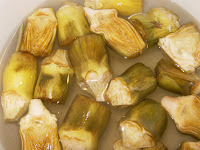Ahem! I said artichokes, not hollandaise sauce. I'm with you though, when I think artichoke, I think steamed with yummy lemon butter dipping sauce. Well, I will be the first to tell you that I may be a changed woman after having baby artichokes roasted.
The beauty of baby artichokes is that the "choke" - or the hairy middle part that you cannot eat - is not yet developed. You can literally trim these and eat almost the whole thing. Now, I read conflicting reports - one saying that baby artichokes are a different breed than their bigger cousins and another saying that they are just less mature versions of their bigger brother. I did some looking and I cannot find a definite answer either way for you, but would love to know if someone out there knows. (Let me know!)
Trimming these puppies is the important part. You want to slice off the top inch or so with a serrated knife to get rid of the sharp, dark green leaves. Peel back the remaining leaves to expose the light green inside leaves. Remove the bottom quarter-inch of the stem and then peel it using a paring knife. Slice the artichokes lengthwise and immediately toss into a lemon water bath to prevent browning - which happens fast!
Toss trimmed artichokes into a pot of boiling water and blanch for 1-2 minutes. These baby chokes are tender enough that this step is optional, but they are certainly ready faster this way as they require less roasting.
I tossed the artichokes with a little bit of good olive oil, fresh garlic, salt and pepper and roasted in a 400F oven for 20 minutes. (Can't WAIT to grill these babies come summer!) They will take well to flavor, so don't be afraid to get a little crazy!
6 months ago

















